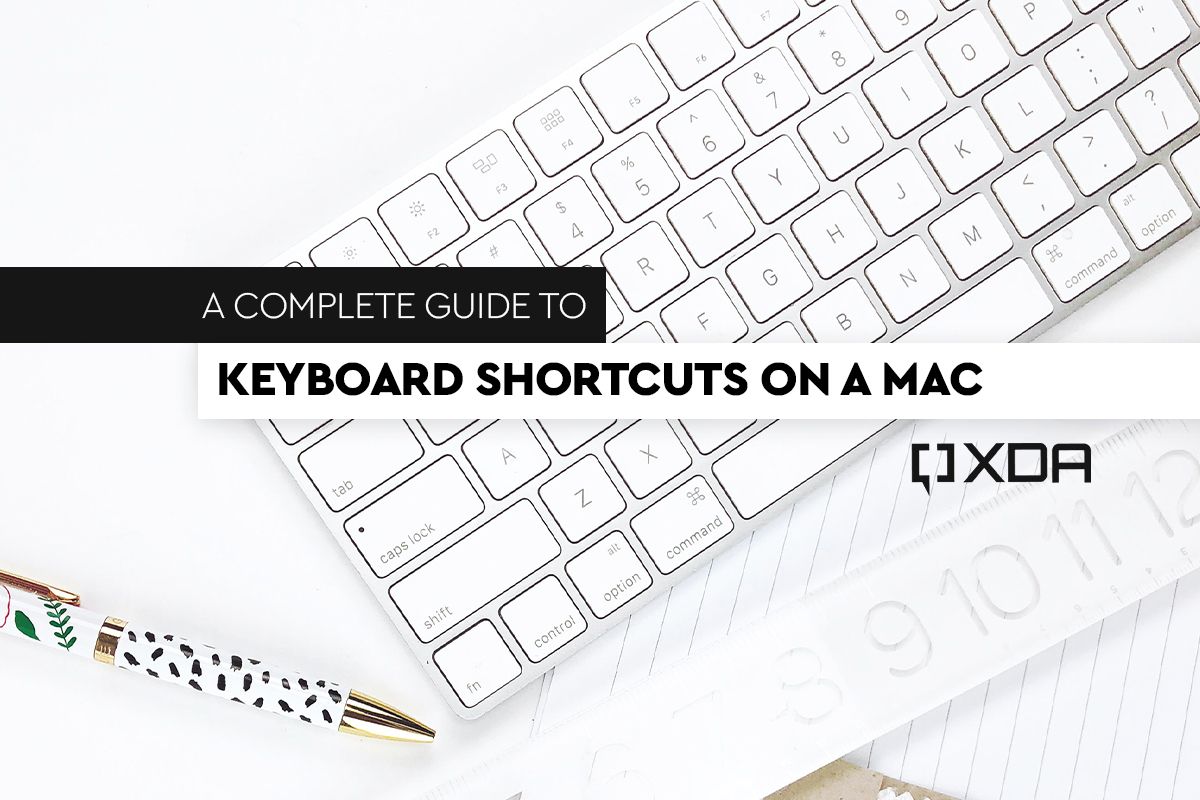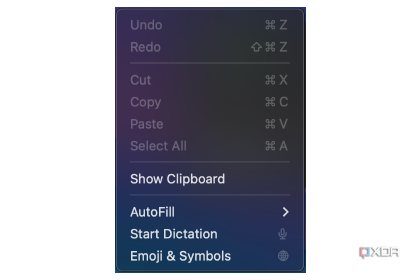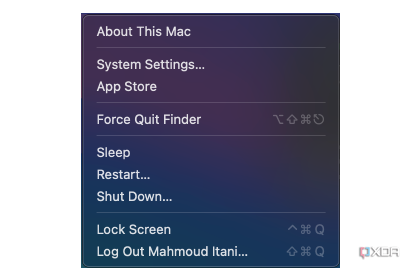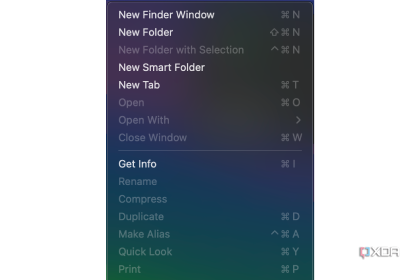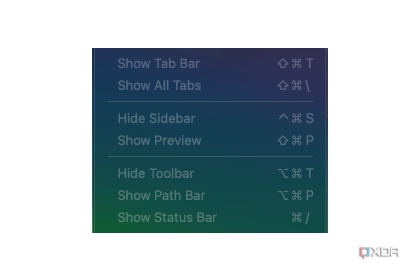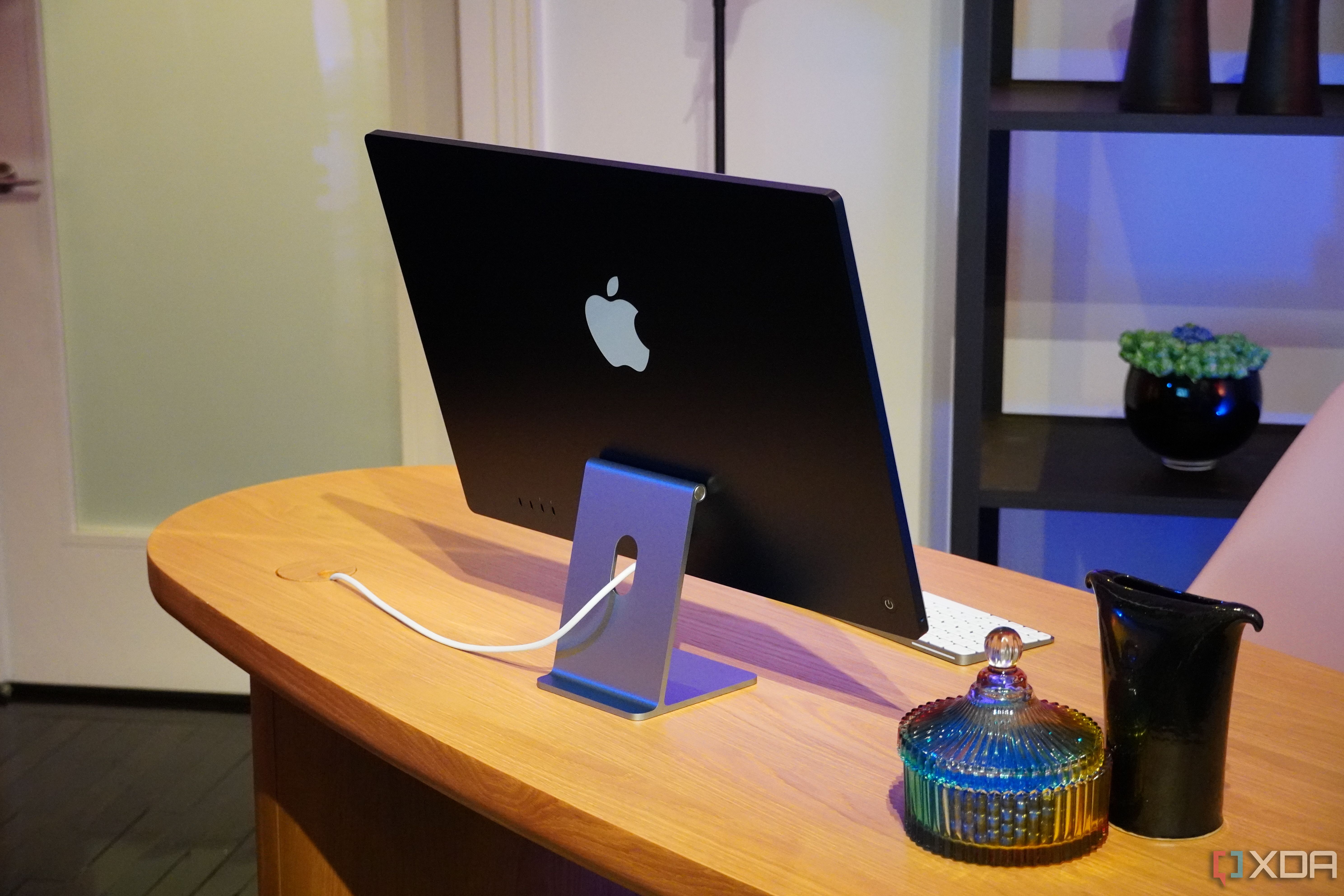Quick Links
The latest Macs are powered by Apple silicon and macOS Sonoma, making them capable yet energy-efficient powerhouses. Their capability, however, doesn't explicitly revolve around the professional app suites they support. The computers themselves pack plenty of advanced features that enable users to make the most out of their time and resources. These include some key combinations that can execute useful tasks. Below, you will find a comprehensive list of the Mac's keyboard shortcuts.
Commonly used Mac shortcuts
Let's start with commonly used Mac shortcuts that users usually rely on when performing everyday tasks.
- Command + X: Cut selected item and copy it to clipboard.
- Command + C: Copy selected item to clipboard. This also works for files in Finder, not only text and photos.
- Command + V: Paste clipboard items into current text field, document, window, or app.
- Command + Z: Undo last command.
- Shift + Command + Z: Redo last undone command.
- Command + A: Select all items in a window, document, or text field.
- Command + F: Find items in an open document or open a new Find window.
- Command + G: Find the next occurrence of a found item.
- Shift + Command + G: Find previous occurrence of a found item.
- Command + H: Hide the windows of the front app.
- Option + Command + H: Hide all apps except for the front window.
- Command + M: Minimize the front window.
- Option + Command + M: Minimize all windows of the front app.
- Command + O: Open a selected item. If none are selected, bring up a prompt to choose a file to open.
- Command + P: Print the opened document.
- Command + S: Save the opened document.
- Command + T: Open a new tab of the front app.
- Command + W: Close the front window.
- Option + Command + W: Close all windows of the front app.
- Option + Command + Esc: Force quit an app. This is particularly useful when an app isn't responsive.
- Command + Space bar: Bring up or close Spotlight Search.
- Option + Command + Space bar: Perform a Spotlight search in a Finder window.
- Control + Command + Space bar: Bring up the Character Viewer to insert emoji and other special characters.
- Control + Command + F: Switch to a full screen window, if the app supports it.
- Space bar: Use Quick Look on a selected item.
- Command + Tab: Switch to the next most recently used (open) app.
- Shift + Command + 5: Open the Screenshot app to take a screenshot or a screen recording.
- Shift + Command + N: Create a new folder in Finder.
- Command + comma: Open the settings of the front app.
Power shortcuts
We then have shortcuts that revolve around your Mac's power state. Though, please note that some of the shortcuts below don't apply to Macs with Touch ID Power buttons.
-
Power button:
- Press to turn on your Mac if it's off or to wake it if it's asleep.
- Press and hold for 1.5 seconds to put your Mac to sleep.
- Press and hold for longer to force your Mac to turn off. This is particularly useful when your Mac is irresponsive.
- Option + Command + Power button: Put your Mac to sleep.
- Control + Shift + Power button: Put your display(s) to sleep.
- Control + Power button: Bring up the Restart/Sleep/Shut Down prompt.
- Control + Command + Power button: Force restart your Mac. Note that unsaved documents and changes will likely be lost. Use this only if your Mac is irresponsive.
- Control + Option + Command + Power button: Quit all open apps, choose whether you want to keep unsaved changes, then Shut Down your Mac.
- Control + Command + Q: Lock your Mac screen.
- Shift + Command + Q: Log out of your macOS user account after confirming.
- Option + Shift + Command: Log out of your macOS user account without confirming.
Finder and system shortcuts
You also have keyboard shortcuts that revolve around the Finder app and other system elements.
- Command + D: Duplicate selected file(s).
- Command + E: Eject selected disk or volume.
- Command + F: Invoke Spotlight Search in a Finder window.
- Command + I: Bring up the Get Info of a selected file.
-
Command + R:
- Show the original file of a selected alias in Finder.
- Reload the page in select apps, such as Safari.
- Check for software updates in Software Update settings.
- Shift + Command + C: Open the Computer folder.
- Shift + Command + D: Open the Desktop folder.
- Shift + Command + F: Open the Recents folder.
- Shift + Command + G: Open the Go to Folder dialogue.
- Shift + Command + H: Open the Home folder of the current macOS user.
- Shift + Command + I: Open the iCloud Drive folder.
- Shift + Command + K: Open the Network folder.
- Option + Command + L: Open the Downloads folder.
- Shift + Command + N: Create a new folder.
- Shift + Command + O: Open the Documents folder.
- Shift + Command + P: Show/hide the Preview pane in Finder windows.
- Shift + Command + R: Open the AirDrop window.
- Shift + Command + T: Show/hide the tab bar in Finder windows.
- Control + Shift + Command + T: Add selected item in Finder to the Dock
- Shift + Command + U: Open the Utilities folder.
- Option + Command + D: Show/hide the Dock.
- Control + Command + T: Add selected item to the sidebar.
- Option + Command + P: Hide/show the path bar in a Finder window.
- Option + Command + S: Hide/show the sidebar in a Finder window.
- Command + Slash: Hide/show the status bar in a Finder window.
- Command + J: Show the View Options.
- Command + K: Open the Connect to Server window.
- Control + Command + A: Set an alias to a selected item.
- Command + N: Open a new Finder window.
- Option + Command + N: Create a new Smart Folder in Finder.
- Command + T: Show/hide the tab bar when only one Finder tab is open in the current window.
- Option + Command + T: Show/hide the toolbar when only one Finder tab is open in the current window.
- Option + Command + V: Move Clipboard files from their initial source to the current location.
- Command + Y: Use Quick Look on a selected item.
- Option + Command + Y: Use a Quick Look slideshow on multiple selected item.
- Command + 1: Switch to Icon View in a Finder window.
- Command + 2: Switch to List View in a Finder window.
- Command + 3: Switch to Column View in a Finder window.
- Command + 4: Switch to Gallery View in a Finder window.
- Command + Left Bracket: Go to previous folder.
- Command + Right Bracket: Go to next folder.
- Command + Up Arrow: Open the folder containing the current one.
- Command + Control + Up Arrow: Open the folder containing the current one in a new Finder window.
- Command + Down Arrow: Open the selected item.
- Right Arrow: When in List View, open the selected folder.
- Left Arrow: When in List View, close the selected folder.
- Command + Delete: Trash selected item(s).
- Shift + Command + Delete: Empty the Trash, if it has any items, after you confirm.
- Option + Shift + Command + Delete: Empty the Trash, if it has any items, without your confirmation.
- Command + Brightness Down: Toggle video mirroring if your Mac is connected to more than one device.
- Option + Brightness Up/Down: Open Displays settings.
- Control + Brightness Up: Turn up the brightness on a supported external display.
- Control + Brightness Down: Turn down the brightness on a supported external display.
- Option + Shift + Brightness Up: Turn up the brightness in smaller steps.
- Option + Shift + Brightness Down: Turn down the brightness in smaller steps.
- Control + Option + Shift + Brightness Up: Turn up the brightness in smaller steps on a supported external display.
- Control + Option + Shift + Brightness Down: Turn down the brightness in smaller steps on a supported external display.
- Option + Mission Control: Open Mission Control settings.
- Command + Mission Control: Show the desktop.
- Control + Down Arrow: Show all open windows of the front app.
- Option + Volume Up/Down: Open Sound settings.
- Option + Shift + Volume Up: Turn up the volume in smaller steps.
- Option + Shift + Volume Down: Turn down the volume in smaller steps.
- Option + Keyboard Brightness Up/Down: Open Keyboard settings.
- Option + Shift + Keyboard Brightness Up: Turn up the keyboard brightness in smaller steps.
- Option + Shift + Keyboard Brightness Down: Turn down the keyboard brightness in smaller steps.
- Option + Double Click: Open item in a new window and close original one.
- Command + Double Click: Open a folder in a separate tab/window.
- Command + Drag to another volume: Move dragged item to new volume rather than copying it.
- Option + Drag: Copy dragged item.
- Option + Command + Drag: Set an alias for the dragged item.
- Command + Click window title: When in List View, open all folders within a selected folder.
Document shortcuts
Lastly, there are dedicated shortcuts for when you're editing or interacting with a certain document on your Mac.
- Command + B: Toggle boldfacing, or boldface selected text.
- Command + I: Toggle italics, or italicize selected text.
- Command + K: Add a URL.
- Command + U: Toggle underlining, or underline selected text.
- Command + T: Show/hide the Fonts window.
- Command + D: Select the Desktop folder when presented with an Open/Save dialogue.
- Control + Command + D: Show/hide the definition of a selected word.
- Shift + Command + Colon: Show the Spelling and Grammar window.
- Command + Semicolon: Find misspelled words in an open document.
- Option + Delete: Delete the word to the left of the cursor.
- Control + H: Delete the character to the left of the cursor. Alternatively, you could just click Delete.
- Control + D: Delete the character to the right of the cursor.
- Control + K: Delete all text between cursor and the end of a line/paragraph.
- Fn + Up Arrow: Scroll one page up (Page Up).
- Fn + Down Arrow: Scroll one page down (Page Down).
- Fn + Left Arrow: Scroll to the beginning of a document (Home).
- Fn + Right Arrow: Scroll to the end of a document (End).
- Command + Up Arrow: Move the cursor to the beginning of a document.
- Command + Down Arrow: Move the cursor to the end of a document.
- Command + Left Arrow: Move the cursor to the beginning of the current line.
- Command + Right Arrow: Move the cursor to the end of the current line.
- Option + Left Arrow: Move the cursor to the beginning of the previous word.
- Option + Right Arrow: Move the cursor to the beginning of the next word.
- Shift + Command + Up Arrow: Select the text between the cursor and the beginning of a document.
- Shift + Command + Down Arrow: Select the text between the cursor and the end of a document.
- Shift + Command + Left Arrow: Select the text between the cursor and the beginning of the current line.
- Shift + Command + Right Arrow: Select the text between the cursor and the end of the current line.
- Shift +Up Arrow: Extend text selection to the nearest character on the same horizontal level on the line above.
- Shift + Down Arrow: Extend text selection to the nearest character on the same horizontal level on the line below.
- Shift + Left Arrow: Extend text selection one character to the left.
- Shift + Right Arrow: Extend text selection one character to the right.
- Option + Shift + Up Arrow: Extend text selection to the beginning of current paragraph. Pressing it again will extend it to the beginning of the following paragraph.
- Option + Shift + Down Arrow: Extend text selection to the end of current paragraph. Pressing it again will extend it to the end of the following paragraph.
- Option + Shift + Left Arrow: Extend text selection to the beginning of current word. Pressing it again will extend it to the beginning of the following word.
- Option + Shift + Right Arrow: Extend text selection to the end of current word. Pressing it again will extend it to the end of the following word.
- Control + A: Move the cursor to the beginning of the line or paragraph.
- Control + E: Move the cursor to the end of the line or paragraph.
- Control + F: Move the cursor one character forward.
- Control + B: Move the cursor one character backward.
- Control + L: Center the cursor or selected text in the visible area.
- Control + P: Move the cursor one line up.
- Control + N: Move the cursor one line down.
- Control + O: Insert a new line after the cursor.
- Control + T: Swap the characters behind and in front of the cursor.
- Command + Left Curly Bracket: Align left.
- Command + Right Curly Bracket: Align right.
- Shift + Command + Vertical Bar: Align center.
- Option + Command + F: Go to search field.
- Option + Command + T: Show/hide the toolbar.
- Option + Command + C: Copy selected text to Clipboard including the formatting.
- Option + Command + V: Paste text from Clipboard including the formatting.
- Shift + Option + Command + V: Paste text from Clipboard while matching the surrounding text's formatting.
- Option + Command + I: Show/hide the inspector window.
- Shift + Command + P: Bring up a window to select document settings.
- Shift + Command + S: Bring up the Save As prompt or duplicate the current document.
- Shift + Command + Minus: Decrease the size of a selected item.
- Shift + Command + Plus: Increase the size of a selected item.
- Command + Equal: Increase the size of a selected item.
- Shift + Command + Question Mark: Bring up the Help menu.
That's everything you need to know about keyboard shortcuts on a Mac! As you can see, there are dozens them, with each serving a unique purpose. While we don't expect you to memorize them all by heart, your muscle memory may automatically register the ones you actively use. In the meantime, you can bookmark this webpage to easily access it whenever you're seeking the key combination of a certain shortcut on your Mac.

